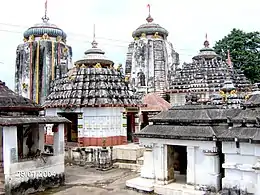Gajapati Kingdom
The Gajapatis were a medieval Hindu dynasty from the Indian subcontinent, which originated in the region of Odradesha (historical region ruled by samrat Odra) (most of present-day Odisha and Northern coastal Andhra) from 1434 to 1541 CE. Under Kapilendra Deva, Gajapatis became an empire stretching from the lower Ganga in the north to the Kaveri in the south.[2]
Gajapati Empire | |||||||||||||
|---|---|---|---|---|---|---|---|---|---|---|---|---|---|
| 1434 CE–1541 CE | |||||||||||||
 The Gajapatis at their height in the mid-15th century | |||||||||||||
| Capital | Cuttack | ||||||||||||
| Common languages | Odia[1] | ||||||||||||
| Religion | Hinduism | ||||||||||||
| Government | Monarchy | ||||||||||||
| King | |||||||||||||
• 1434–66 | Kapilendra Deva | ||||||||||||
• 1466–97 | Purushottama Deva | ||||||||||||
• 1497–1540 | Prataprudra Deva | ||||||||||||
• 1540–1541 | Kalua Deva | ||||||||||||
• 1541 | Kakharua Deva | ||||||||||||
| Historical era | Medieval India | ||||||||||||
• Established | 1434 CE | ||||||||||||
• Disestablished | 1541 CE | ||||||||||||
| |||||||||||||
The Gajapati dynasty was established by Emperor Kapilendra Deva (1434–66 CE) in 1434. During the reign of Kapilendra Deva, the borders of the empire were expanded immensely; from large parts of Andhra Pradesh and West Bengal, and the eastern and central parts of Madhya Pradesh and Jharkhand. The king took the title of Sri Sri ... (108 times) Gajapati Gaudesvara Nava Koti Karnata Kalvargesvara. This title is still used by their descendants at Puri during the Ratha Yatra. The significant rulers of this dynasty were Purushottama Deva (1466–1497) and Prataparudra Deva (1497–1540). The last ruler Kakharua Deva was killed by Govinda Vidyadhara in 1541, who founded the Bhoi dynasty.
Etymology
In Odia, "Gaja" means elephant and "Pati" means master or husband. As such, Gajapati etymologically means a king with an army of elephants.
History
The region known as Kalinga (present-day Odisha) was controlled by the Odia rulers Eastern Gangas of the Vasistha gotra. The early Eastern Gangas ruled from Kalinga-nagara (Mukhalingam near Srikakulam, Andhra Pradesh). They shifted their capital to Cuttack in the 13th century. Religious leader Ramanujacharya had a great influence on the Raja Choda Ganga Deva, who renovated the temple at Puri. Narasingha Deva built the Sun Temple at Konark. The Gangas were succeeded by the Gajapati rulers. Two copper plates of the early Pallava dynasty have been found in the Kolleru Lake, traced to Gajapati Langula Narasimha Deva, an Oriya ruler (Odia Raja). According to legend, the Gajapati fort was located at Kolleti Kota on one of the eastern islands of the lake, which protected the Odia forces. The enemy general encamped at Chiguru Kota located on the shores and tried to excavate a channel in the modern-day Upputeru, so that the water of the lake would empty into the sea and allow an attack on the Gajapati fort.
The Gajapatis of Odisha, at the height of their power in the 15th century, ruled over an empire extending from the Ganges in the north near Hoogly to the Cauvery in the south under Gajapati Kapilendra Deva.[3] But by the early 16th century, the Gajapatis lost great portions of their southern dominion to Vijayanagar and Golconda. This period was marked by the influence of Chaitanya Mahaprabhu and by the expansion of Jaganatha temple across the length and breadth of the empire. One of the causes of the reduction in militarism of the population has been attested to the Bhakti movement initiated by Sri Chaitanya Mahaprabhu, who arrived in the empire at the time of Emperor Prataparudra and stayed for 18 long years at Puri. Emperor Prataparudra was highly influenced by the works of Chaitanya and gave up the military tradition of the Odia emperors. He retired himself into the life of an ascetic leaving the future of the empire uncertain. Govinda Vidyadhara took the opportunity to murder the sons of the emperor and usurped the throne himself and carved out the destruction of the once mighty empire.
Rulers
- Kapilendra Deva (1434–70)[4]
- Purushottama Deva (1470–97)
- Prataparudra Deva (1497–1540)
- Kalua Deva (1540–41)
- Kakharua Deva (1541)
Regnal year (Anka year)
| Ruler | Reign | Regnal year duration | Anka year duration |
|---|---|---|---|
| Kapilendra Deva | 1434–70 | 36 | 44 |
| Purushottama Deva | 1470–97 | 27 | 33 |
| Prataparudra Deva | 1497–1540 | 43 | 53 |
| Kalua Deva | 1540–41 | 2 | 3 |
| Kakharua Deva | 1541 | 1 | 2 |
Gallery
| Outline of South Asian history |
|---|
_without_national_boundaries.svg.png.webp) |
 15th century copper plate grant of Gajapati emperor Purushottama Deva
15th century copper plate grant of Gajapati emperor Purushottama Deva Lingaraj Temple Inscription of Kapilendra Deva
Lingaraj Temple Inscription of Kapilendra Deva Kapileswar Temple at old Bhubaneswar built during Kapilendra Deva
Kapileswar Temple at old Bhubaneswar built during Kapilendra Deva Narendra tank at Puri built during the rule of Kapilendra Deva
Narendra tank at Puri built during the rule of Kapilendra Deva
See also
References
- Srichandan, G. K. (February–March 2011). "Classicism of Odia Language" (PDF). Orissa Review. p. 54. Retrieved 28 June 2019.
- Majumdar, Ramesh Chandra; Pusalker, A. D.; Majumdar, A. K., eds. (1960). The History and Culture of the Indian People. VI: The Delhi Sultanate. Bombay: Bharatiya Vidya Bhavan. p. 367.
[Describing the Gajapati kings of Orissa] Kapilendra was the most powerful Hindu king of his time, and under him Orissa became an empire stretching from the lower Ganga in the north to the Kaveri in the south.
- A History of South India, K.A. Nilakanta Sastri
- Sen, Sailendra (2013). A Textbook of Medieval Indian History. Primus Books. pp. 121–122. ISBN 978-9-38060-734-4.
- Majumdar, Ramesh Chandra; Pusalker, A. D.; Majumdar, A. K., eds. (1960). The History and Culture of the Indian People. VI: The Delhi Sultanate. Bombay: Bharatiya Vidya Bhavan. pp. 365–372.
